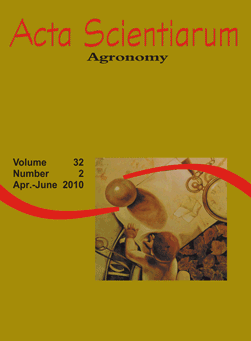<b>Influence of gibberellic acid on the architecture of common bean plants at early growth development</b> - DOI: 10.4025/actasciagron.v32i2.3721
Keywords:
Phaseolus vulgaris, gibberellins, stem elongation, hypocotyl, epicotyl
Abstract
The low height of pod insertion in beans is due to the low height of its basal internodes that lead to problems in plant management, low grain quality and inefficient commercial harvest. The objective of this work was to evaluate the effect of exogenous gibberellic acid (GA3) to increase basal internodes of bean seedlings. The experiment was conducted in greenhouse and field growth conditions, using two common bean genotypes. In both, the seeds were treated with 10 µM GA3; spraying on seedling shoot (hook, primary leaves, first and second trifoliate leaf) with 10 µM GA3, and control using distilled water. The plants were harvested at V4 stage. GA3 promoted significant increase of the hypocotyl and epicotyl (first internodes 9 cm) length, and decrease of their respective diameters, particularly with GA3 seed treatment. The genotype BAF#55 was more responsive to GA3 treatments than Carioca Iapar#81. Moreover, a reduction in leaf area was observed in all dimensions (length-to-width ratio). In the seed treatment, the emergence was 34% for IAPAR#81 against 71% for BAF#55, and around 90% for controls. It indicates that GA3 modifies plant architecture, whose response depends on genotype, the environment and the physiological development stage of the plant.Downloads
Download data is not yet available.
Published
2010-04-27
How to Cite
Souza, C. A., Coelho, C. M. M., Guidolin, A. F., Engelsing, M. J., & Bordin, L. C. (2010). <b>Influence of gibberellic acid on the architecture of common bean plants at early growth development</b> - DOI: 10.4025/actasciagron.v32i2.3721. Acta Scientiarum. Agronomy, 32(2), 325-332. https://doi.org/10.4025/actasciagron.v32i2.3721
Issue
Section
Crop Production
DECLARATION OF ORIGINALITY AND COPYRIGHTS
I Declare that current article is original and has not been submitted for publication, in part or in whole, to any other national or international journal.
The copyrights belong exclusively to the authors. Published content is licensed under Creative Commons Attribution 4.0 (CC BY 4.0) guidelines, which allows sharing (copy and distribution of the material in any medium or format) and adaptation (remix, transform, and build upon the material) for any purpose, even commercially, under the terms of attribution.
2.0
2019CiteScore
60th percentile
Powered by 

2.0
2019CiteScore
60th percentile
Powered by 



















































